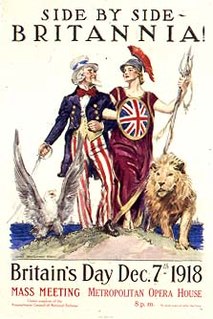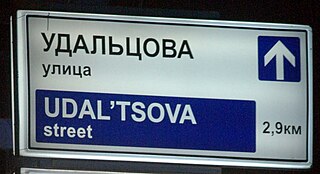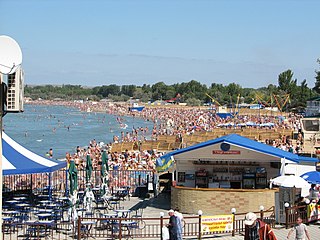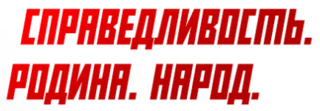Since medieval times personifications of Russia are traditionally feminine, and most commonly are maternal. [1]
Contents
![A cover of Sentry [ru
] magazine, approx. 1932, depicting Russia as a woman in a traditional costume liberated by a warrior in medieval armor, trampling the Bolshevik flag. Thecristisrizenoldrussiancivilwarposter.jpg](http://upload.wikimedia.org/wikipedia/commons/thumb/0/0e/Thecristisrizenoldrussiancivilwarposter.jpg/359px-Thecristisrizenoldrussiancivilwarposter.jpg)
Most common terms for national personification of Russia are:

A national personification is an anthropomorphism of a nation or its people. It may appear in editorial cartoons and propaganda.

Russia, officially the Russian Federation, is a transcontinental country in Eastern Europe and North Asia. At 17,125,200 square kilometres (6,612,100 sq mi), Russia is by a considerable margin the largest country in the world by area, covering more than one-eighth of the Earth's inhabited land area, and the ninth most populous, with about 146.77 million people as of 2019, including Crimea. About 77% of the population live in the western, European part of the country. Russia's capital, Moscow, is one of the largest cities in the world and the second largest city in Europe; other major cities include Saint Petersburg, Novosibirsk, Yekaterinburg and Nizhny Novgorod. Extending across the entirety of Northern Asia and much of Eastern Europe, Russia spans eleven time zones and incorporates a wide range of environments and landforms. From northwest to southeast, Russia shares land borders with Norway, Finland, Estonia, Latvia, Lithuania and Poland, Belarus, Ukraine, Georgia, Azerbaijan, Kazakhstan, China, Mongolia and North Korea. It shares maritime borders with Japan by the Sea of Okhotsk and the U.S. state of Alaska across the Bering Strait. However, Russia recognises two more countries that border it, Abkhazia and South Ossetia, both of which are internationally recognized as parts of Georgia.
- Mother Russia (Russian : Матушка Россия, tr. Matushka Rossiya, "Mother Russia"; also, Россия-матушка, tr. Rossiya-matushka, "Russian Mother", Мать-Россия, tr. Mat'-Rossiya, Матушка Русь, tr. Matushka Rus' , "Mother Rus' "),
- Mother Motherland (Russian : Родина-мать, tr. Rodina-mat' ).

Russian is an East Slavic language, which is official in the Russian Federation, Belarus, Kazakhstan and Kyrgyzstan, as well as being widely used throughout Eastern Europe, the Baltic states, the Caucasus and Central Asia. It was the de facto language of the Soviet Union until its dissolution on 25 December 1991. Although nearly three decades have passed since the breakup of the Soviet Union, Russian is used in official capacity or in public life in all the post-Soviet nation-states, as well as in Israel and Mongolia.

Romanization of Russian is the process of transliterating the Russian language from the Cyrillic script into the Latin script.
Notice that in the Russian language, the concept of motherland is rendered by two terms: "родина" ( tr. rodina), literally, "place of birth" and "отчизна" ( tr. otchizna), literally "fatherland".
Harald Haarmann and Orlando Figes see the goddess Mokosh a source of the "Mother Russia" concept. [2] [3]
Harald Haarmann is a German linguist and cultural scientist who lives and works in Finland. Haarmann studied general linguistics, various philological disciplines and prehistory at the universities of Hamburg, Bonn, Coimbra and Bangor. He obtained his PhD in Bonn (1970) and his habilitation in Trier (1979). He taught and conducted research at a number of German and Japanese universities and is a member of the Research Centre on Multilingualism in Brussels. He is Vice-President of the Institute of Archaeomythology and director of its European branch.

Orlando Guy Figes ( is a British historian and writer known for his works on Russian and European history. He is professor of history at Birkbeck College, University of London.

Mokosh is a Slavic goddess mentioned in the Primary Chronicle, protector of women's work and women's destiny. She watches over spinning and weaving, shearing of sheep, and protects women in childbirth. Mokosh is the Great Mother.














